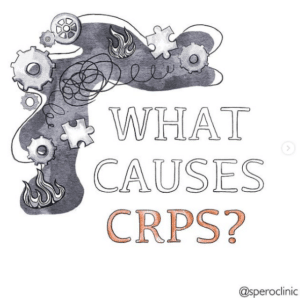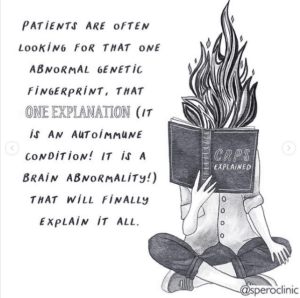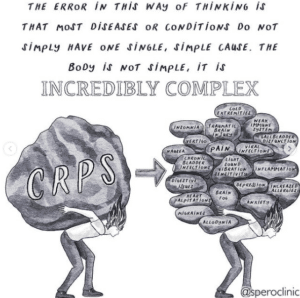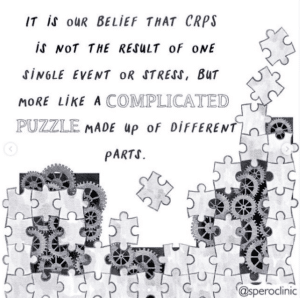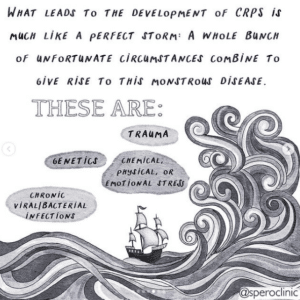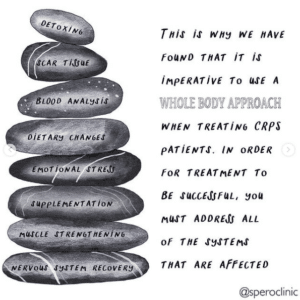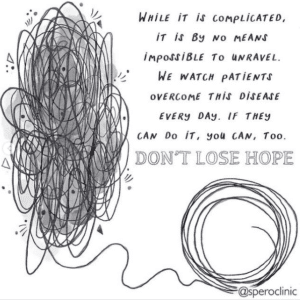If you are suffering from Complex Regional Pain Syndrome, or you love or care about someone who suffers from CRPS, you’ve probably already asked yourself “Why me?” “Why them?” “How did this happen?”
Often, patients will think – if only. If only I didn’t twist my ankle that day. If only I didn’t fall on that filing cabinet. If only I wasn’t in that car accident. I have news for you that might help you in some way.
This is my hypothesis, and strong belief, based on all of my experience and the hundreds of CRPS patients that I treated: The accident that finally triggered your pain was not the only thing that caused your pain.
What Causes CRPS?
Your body was in trouble and it was sick and set up to develop Complex Regional Pain Syndrome. This can happen because of things like your genetics, the inflammation in your body, emotional trauma, underlying infections you were not aware of. The injury was simply the last straw that broke the camel’s back.
Another way to look at that is to think of it as the perfect storm, where all these things come together, and the result of that was Complex Regional Pain Syndrome.
It is important that you understand that CRPS was not caused by just one event, and if you’re going to heal it, it’s not just going to be healed by one thing or one procedure. It has to be turned around, as a whole, so that the body can heal from within, as a whole.
Early Signs and Symptoms of CRPS
The symptoms and conditions listed are often associated with or can be related to Complex Regional Pain Syndrome (CRPS):
- Childhood Asthma: While not directly related to CRPS, childhood asthma is a separate respiratory condition characterized by airway inflammation and bronchoconstriction. It is not a symptom of CRPS.
- Brain Fog and Memory Loss: Some individuals with CRPS may experience cognitive difficulties, including brain fog and memory issues, as a result of chronic pain and the impact of the condition on overall well-being.
- Chronic Bladder Infections: Chronic bladder infections can be a separate medical issue and are not typically considered a direct symptom of CRPS.
- CRPS Spreading to Other Areas: CRPS can sometimes spread to other areas of the body, a phenomenon known as “spreading” or “generalization.” This occurs when the symptoms extend beyond the initial site of injury. It is a characteristic feature of CRPS.
- Decreased Immune Function: Chronic pain and stress associated with CRPS may potentially impact immune function, but this is not a universally recognized symptom of CRPS.
- GI Dysfunction: Gastrointestinal (GI) dysfunction, such as digestive problems, may be associated with chronic pain conditions like CRPS due to the complex interaction between the nervous system and the GI tract.
- Insomnia: Insomnia or sleep disturbances can be linked to chronic pain conditions, including CRPS, due to the discomfort and pain experienced by individuals.
- Past Viral and/or Bacterial Infections: Past infections may not be direct symptoms of CRPS, but infections or immune responses could potentially contribute to the development or exacerbation of CRPS in some cases.
- POTS and EDS: Postural Orthostatic Tachycardia Syndrome (POTS) and Ehlers-Danlos Syndrome (EDS) are separate conditions that can coexist with CRPS. EDS is a connective tissue disorder that can increase the risk of developing CRPS, and POTS can be associated with autonomic nervous system dysfunction seen in some CRPS cases.
- PTSD: Post-Traumatic Stress Disorder (PTSD) can develop in response to traumatic events, including severe injuries that may lead to CRPS. While PTSD and CRPS can coexist, they are distinct conditions with different diagnostic criteria.
It’s important to note that while some of these symptoms and conditions may occur alongside CRPS, they may also have other underlying causes. Proper medical evaluation and diagnosis are essential for accurate understanding and management of these health concerns.
CRPS Triggers and Catalysts
CRPS (Complex Regional Pain Syndrome) triggers and catalysts refer to various factors, events, or conditions that can exacerbate or activate the symptoms of CRPS in individuals who are already predisposed to the condition. These triggers and catalysts can lead to an escalation of pain, inflammation, and other manifestations of CRPS. While CRPS is a complex condition with multiple contributing factors, certain triggers and catalysts may include:
- Physical Injury or Trauma: A specific injury, surgery, or trauma can act as a trigger for CRPS. Even minor injuries may lead to an abnormal response in the nervous system and contribute to the development of CRPS.
- Surgery or Medical Procedures: Surgical interventions, especially those involving nerves or joints, can potentially initiate or worsen CRPS symptoms.
- Infections: Underlying infections, such as bacterial or viral infections, can trigger an immune response that affects the nervous system and contributes to CRPS symptoms.
- Nervous System Dysregulation: Any event that disrupts the normal functioning of the nervous system, such as trauma or surgery, can serve as a catalyst for the development of CRPS.
- Genetic Predisposition: Genetic factors may make certain individuals more susceptible to developing CRPS, and specific genetic traits can contribute to the expression of symptoms.
- Inflammation: Chronic inflammation in the body, whether due to injury, infection, or other causes, can play a role in the initiation and progression of CRPS.
- Emotional Stress or Trauma: Psychological stressors or trauma may influence the nervous system’s response and contribute to the manifestation of CRPS symptoms.
- Autoimmune Responses: Abnormal immune responses may contribute to the development of CRPS, as the immune system may target healthy tissue, leading to pain and inflammation.
- Temperature Changes: Exposure to extreme temperatures or changes in temperature can trigger or worsen CRPS symptoms, leading to increased pain and sensitivity.
- Movement and Activity: Certain movements or activities that stress the affected limb or area may trigger CRPS symptoms or exacerbate existing pain.
- Hormonal Fluctuations: Hormonal changes, such as those associated with menstruation or menopause, may influence the nervous system and impact CRPS symptoms.
- Underlying Health Conditions: Pre-existing health conditions, such as autoimmune disorders, may contribute to the development or worsening of CRPS.
It’s important to note that individual responses to triggers and catalysts can vary widely, and not everyone exposed to these factors will develop CRPS. Understanding potential triggers and catalysts can help individuals with CRPS manage their condition and make informed decisions about their treatment and lifestyle choices.
CRPS Recovery and Long-Term Management
Recovery from Complex Regional Pain Syndrome (CRPS) involves a comprehensive and holistic approach that extends beyond mere symptom relief. At Spero Clinic, we prioritize a long-term management strategy that aims to empower patients with the tools to regain control over their lives. Our multidimensional approach addresses not only physical symptoms but also the emotional and psychological aspects of CRPS. By fostering a partnership between patients and our medical team, we work collaboratively to optimize well-being, enhance functionality, and promote sustainable recovery. Through personalized treatment plans, ongoing support, and education, we guide patients toward a path of improved quality of life and lasting relief from CRPS.
Contact Us Today
The Spero Clinic is accepting new patients who are suffering from conditions like CRPS, Ehlers-Danlos syndrome, Fibromyalgia, and more. Contact us today.


